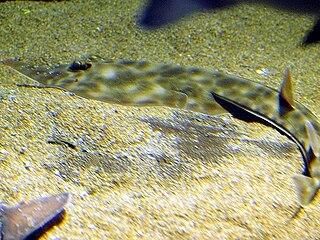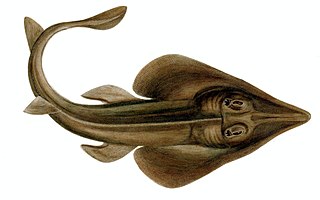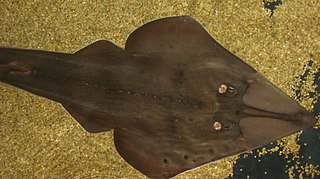
The guitarfish, also referred to as shovelnose rays, are a family, Rhinobatidae, of rays. The guitarfish are known for an elongated body with a flattened head and trunk and small, ray-like wings. The combined range of the various species is tropical, subtropical, and warm temperate waters worldwide.

The shovelnose guitarfish, Pseudobatos productus, is a ray in the family Rhinobatidae. It becomes mature at an estimated seven to eight years old. Males are between 90–100 cm (35–39 in) long, while females are around 99 cm (39 in) at that age. The ray can live up to 11 years, and full-grown sizes are around 120 cm (47 in) for males, and females reach 137 cm (54 in). They range from central California south to the Gulf of California. Morphological and genetic variations occur in the mitochondrial DNA in those found in the Gulf of California, evidencing their isolation from the rest. Because of this, the conservation of this species must be carefully managed to preserve the biological diversity. The shovelnose is considered to be a primitively developed ray, with many features of both sharks and rays.
Hydrophis annandalei, commonly known as Annandale's sea snake or the bighead sea snake, is a species of venomous snake in the subfamily Hydrophiinae of the family Elapidae. The species, which is sometimes placed in its own genus Kolpophis, is native to parts of the Indian Ocean.
The white-spotted guitarfish is a type of ray. It is found in the eastern Atlantic from the Gulf of Guinea to Angola. It reaches a length of approximately 75 cm.
Annandale's rat is a species of rodent in the family Muridae. It is found in Indonesia (Sumatra), Peninsular Malaysia, and Singapore. It was classified as Rattus annandalei until 2017, but mitochondrial and nuclear DNA show that it belongs to the rat genus Sundamys.

The thornback guitarfish is a species of ray in the family Platyrhinidae, and the only member of its genus. Despite its name and appearance, it is more closely related to electric rays than to true guitarfishes of the family Rhinobatidae. This species ranges from Tomales Bay to the Gulf of California, generally in inshore waters no deeper than 6 m (20 ft). It can be found on or buried in sand or mud, or in and near kelp beds. Reaching 91 cm (36 in) in length, the thornback guitarfish has a heart-shaped pectoral fin disc and a long, robust tail bearing two posteriorly positioned dorsal fins and a well-developed caudal fin. The most distinctive traits of this plain-colored ray are the three parallel rows of large, hooked thorns that start from the middle of the back and run onto the tail.

Rhinobatos is a genus of fish in the Rhinobatidae family. Although previously used to encompass all guitarfishes, it was found to be polyphyletic, and recent authorities have transferred many species included in the genus to Acroteriobatus, Glaucostegus, and Pseudobatos.

The brown guitarfish is a species of fish in the Rhinobatidae family. It is found in western Pacific of Taiwan and the Philippines. Its natural habitats are open seas, shallow seas, coral reefs, and estuarine waters. The Taiwan guitarfish was formerly considered a distinct species, but is now considered a junior synonym.

The Brazilian guitarfish is a species of fish in the family Rhinobatidae. It is endemic to Brazil, where its natural habitat is coastal waters on the continental shelf. This fish is viviparous and has a long gestation period, concluding with the birth of live pups in February. At this time the fish are subject to intense fishing activity but catches have been dwindling in recent years as a result of overfishing. Because so few breeding-size fish remain, the International Union for Conservation of Nature has assessed the fish's conservation status as being "critically endangered".

The ringstreaked guitarfish is a species of fish in the Rhinobatidae family found in China, Japan, South Korea, Taiwan, and Vietnam. Its natural habitats are open seas, shallow seas, coral reefs, and estuarine waters.
The bareback shovelnose ray or nakedback guitarfish, is a species of fish in the Rhinobatidae family. It is found in Seychelles and Mauritius. Its natural habitat is open seas.
The Zanzibar guitarfish is a species of fish in the Rhinobatidae family endemic to Tanzania. Its natural habitats are open seas and shallow seas.

The banded guitarfish, mottled guitarfish, prickly skate or striped guitarfish is a species of fish in the Trygonorrhinidae family. Originally Z. exasperata was placed in the Rhinobatidae family, however recent mitochondrial DNA analysis shows their placement into the new family of Trygonorrhinidae. They are found from shallow water to a depth of 200 m (660 ft) in the East Pacific from California, United States, to Mazatlan, Mexico, including the Gulf of California. The species has also been recorded further south, but this likely involves its close relative, the southern banded guitarfish.

The common guitarfish is a species of cartilaginous fish in the family Rhinobatidae. It is native to the eastern Atlantic Ocean and the Mediterranean Sea. It is a bottom-dwelling fish feeding on crustaceans, other invertebrates and fish. The females give birth to live young. Its lifestyle makes it vulnerable to trawling and other fishing methods, populations seem to be declining and it has disappeared from parts of its range.

The blackchin guitarfish is a species of cartilaginous fish in the family Rhinobatidae. It is native to the eastern Atlantic Ocean and the Mediterranean Sea. It is a bottom-dwelling fish feeding on crustaceans, other invertebrates and fish. The females give birth to live young. Its lifestyle makes it vulnerable to trawling and other fishing methods, populations seem to be declining and it is subject to intensive fishing pressure, with its fins being sold into the Asian market. The International Union for Conservation of Nature has assessed its conservation status as being "critically endangered".

Acroteriobatus is a genus of fish in the Rhinobatidae family. Although its constituent species were previously assigned to Rhinobatos, recent authors treat it as distinct.

Pseudobatos is a genus of fish in the Rhinobatidae family. Although its constituent species were previously assigned to Rhinobatos, recent authors treat it as distinct.

Acroteriobatus leucospilus, the grayspotted guitarfish, is a species of guitarfish of the family Rhinobatidae, found along the coast of Madagascar, South Africa, Mozambique, and Tanzania. It has undergone a reduction in population of at least 50% over the past 15 years due to the alarming rate of overfishing and harvesting.












